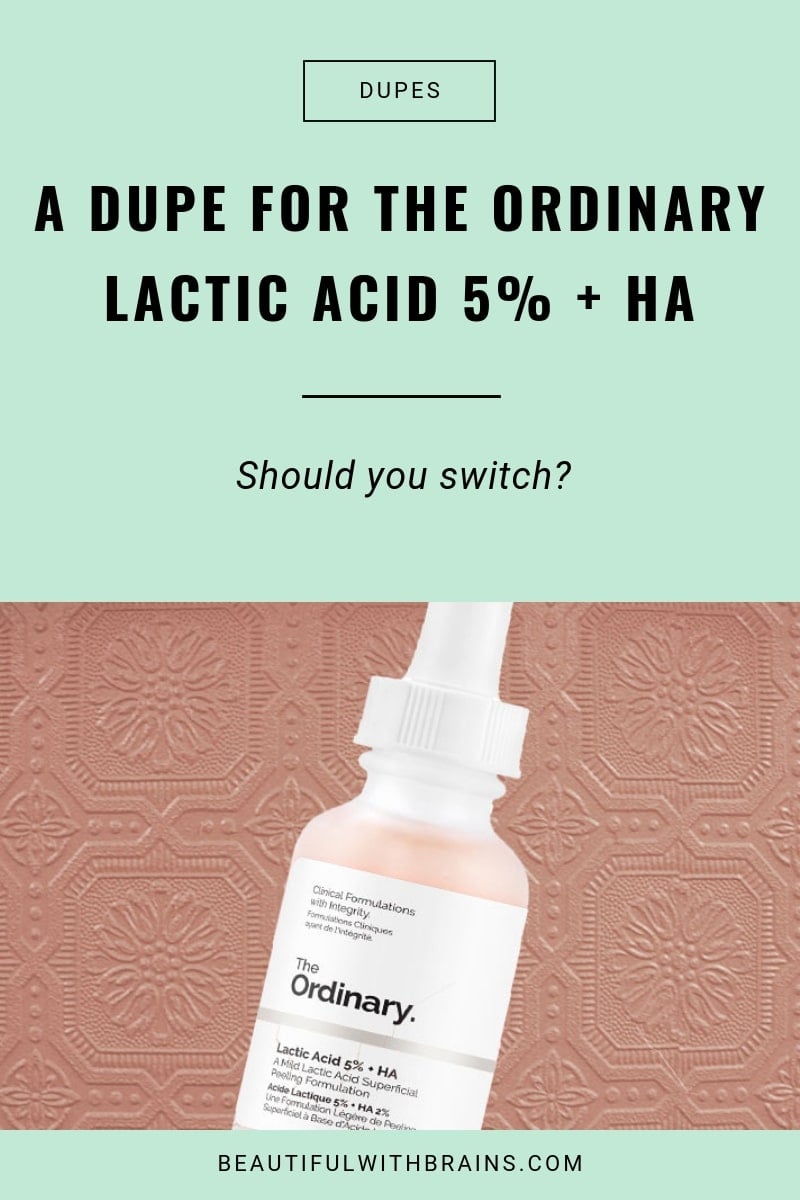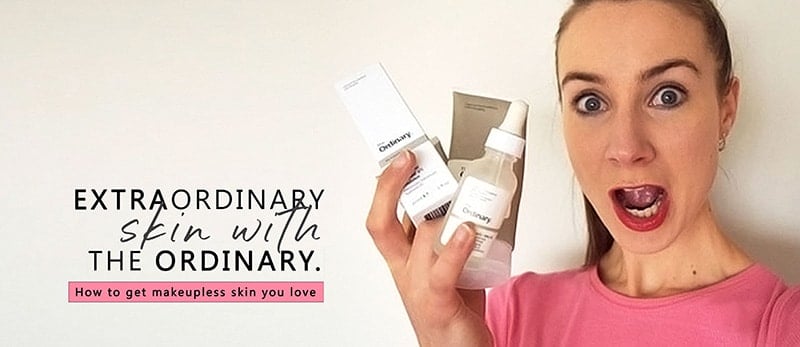
Revolution 5% Lactic Acid + Hyaluronic Acid is a copycat – and is not even trying to hide it. Everything about it, from its sciencey name to the sleek bottle with dropper applicator, is almost identical to The Ordinary Lactic Acid 5% + HA. I have to admit, I’m a bit put off by this. I know there’s nothing really new under the skincare sun (so many formulas are the same), but couldn’t they have given Revolution Skincare its own identity? To me, it feels like the girl who’s trying too hard to get noticed at a party… But is it any good? Does Revolution 5% Lactic Acid + Hyaluronic Acid live up to The Ordinary Lactic Acid 5% + HA, or is it all smoke and mirrors? Let’s find out:
- What Do The Ordinary Lactic Acid 5% + HA And Revolution 5% Lactic Acid + Hyaluronic Acid Have In Common?
- What Else Is In The Ordinary Lactic Acid 5% + HA And Revolution 5% Lactic Acid + Hyaluronic Acid?
- What’s The Texture Like?
- What’s The Packaging Like?
- How To Use Them
- Which Of The Two Should You Go For?
- Availability
- Is Revolution 5% Lactic Acid + Hyaluronic Acid A Dupe For The Ordinary Lactic Acid 5% + HA?
If you’re worrying about doing The Ordinary wrong, get your butt on this The Ordinary speed training. (affiliate link) It’s by my scientist friend Cheryl Woodman and in it she’s teaching you how to use The Ordinary to get makeupless skin you love.

What Do The Ordinary Lactic Acid 5% + HA And Revolution 5% Lactic Acid + Hyaluronic Acid Have In Common?
LACTIC ACID TO EXFOLIATE SKIN
Both Revolution 5% Lactic Acid + Hyaluronic Acid and The Ordinary Lactic Acid 5% + HA have opted for Lactic Acid, the gentlest of the Alpha Hydroxy Acids (AHAs). AHAs are a family of exfoliants that dissolves the “glue” that holds skin cells together, so they can slough off and reveal the smoother and brighter skin underneath.
Lactic Acid goes one step further: it also hydrates it. It works by attracting moisture from the environment into the skin and binding it there. One more thing: Lactic Acid is a big molecule, which has a hard time penetrating the skin. That means it’s not as effective as other exfoliating acids (like Glycolic) to brighten skin, but it does the job way more gently.
If you have sensitive skin, lactic acid is the way to go.
Related: Glycolic Acid VS Lactic Acid: Which One Is Right For You?
HYALURONIC ACID TO HYDRATE SKIN
Both Revolution 5% Lactic Acid + Hyaluronic Acid and The Ordinary Lactic Acid 5% + HA use the same form of Hyaluronic Acid: Sodium Hyaluronate Crosspolymer (we’ll call it SMC from now on). SMC is a modified, smaller form of Hyaluronic Acid attached to a polymer structure that allows it to hydrate skin for longer.
It works like this: when SMC enters your skin, the enzymes there break down the bond between its molecular structure. Now the polymer can roam free all over your skin’s upper layers, making sure they have all the moisture they need for hours on end.
All this extra moisture makes your skin very happy: it plumps up your fine lines and wrinkles so they look smaller; it makes its texture softer to the touch; and it imparts a radiant glow.
Related: Why You Need Hyaluronic Acid In Your Skincare Routine, No Matter Your Skin Type
TASMANIAN PEPPERBERRY TO SOOTHE SKIN
The Ordinary was the first to make Tasmanian Pepperberry popular. It’s literally in all its exfoliants, including Lactic Acid 5% + HA. Revolution 5% Lactic Acid + Hyaluronic Acid copied this too. Was it a good choice? What is this Tasmanian thingie?
Tasmanian Pepperberry is a little berry rich in flavonoids, a family of antioxidants with anti-inflammatory properties. It reduces redness and irritation and helps sensitive skin better tolerate lactic acid.
Related: Skin Irritations: Cause And Prevention
What Else Is In The Ordinary Lactic Acid 5% + HA And Revolution 5% Lactic Acid + Hyaluronic Acid?
NOTE: The colours indicate the effectiveness of an ingredient. It is ILLEGAL to put toxic and harmful ingredients in skincare products.
- Green: It’s effective, proven to work, and helps the product do the best possible job for your skin.
- Yellow: There’s not much proof it works (at least, yet).
- Red: What is this doing here?!
REVOLUTION 5% LACTIC ACID + HYALURONIC ACID INGREDIENTS
- Aqua/Water/Eau: The main solvent in the formula, it helps other ingredients dissolve as well.
- Propanediol: A solvent, often naturally-derived from corn, that helps other ingredients better penetrate skin from maximum effectiveness.
- Glycerin: A humectant that draws moisture from the air into your skin, increasing its moisture levels, so it stays softer and suppler for longer.
- Butylene Glycol: It’s a humectant that increases skin’s hydration levels, so it stays softer and suppler for longer. It’s also a solvent and helps other active ingredients better penetrate skin, too.
- Xanthan Gum: It thickens the texture of skincare products.
- Sodium Benzoate: A preservative that inhibits the growth of bacteria and fungi, keeping your skincare products safe for longer.
- Potassium Sorbate: A weak preservative. It must be used together with other preservative to keep the product safe from germs and bacteria.
- Disodium Edta: A chelating agent, a fancy ways of saying it binds to the trace elements in the water that may spoil the formula and neutralises them.
- Pentylene Glycol: A solvent that also helps other ingredients better penetrate skin.
- Ethylhexylglycerin: A mild humectant with preservative-like properties. It makes skin softer and helps your skincare products last longer.
THE ORDINARY LACTIC ACID 5% + HA INGREDIENTS
- Aqua (water): The main solvent in pretty much most skincare products, it helps other ingredient dissolve.
- Glycerin: A common humectant, a fancy way of calling ingredients that draw moisture from the air into the skin. This makes skin softer, suppler, and hydrated for longer.
- Pentylene Glycol: Another humectant that makes skin softer and smoother. It also acts as a solvent and helps other ingredients better penetrate skin.
- Triethanolamine: It helps to adjust the pH of skincare products.
- Potassium Citrate: Another pH adjuster.
- Arginine: An amino acid naturally found in your body. It has both hydrating and antioxidant properties.
- Acacia Senegal Gum: It thickens the texture of skincare products.
- Xanthan Gum: Another thickening agent.
- Trisodium Ethylene-Diamine Disuccinate: A chelating agent that binds to the trace metals in the water and neutralises them, so they can’t spoil the formula.
- PEG-40 Hydrogenated Castor Oil: An emollient that makes skin softer and smoother to the touch.
- Ethyl 2.2-Dimethylhydrocinnamal: A fragrance ingredient also called Florazon. It has a fresh, marine smell with a hint of floral. It may cause irritations in sensitive skin.
- PPG-26-Buteth-26: It helps reduce flaky skin.
- Ethylhexylglycerin: A hydrating ingredient with preservative-like properties that help your skincare products last longer.
- 1.2-Hexanediol: A synthetic preservative that keeps your skincare products safe from bacteria contamination.
- Caprylyl Glycol: A humectant that hydrates skin.
WHICH FORMULA IS BETTER?
The two formulas are very similar but Revolution has a big dollop of Propanediol, a type of alcohol that helps active ingredients penetrate deeper into the skin. The catch? If you have sensitive skin, it could irritate it.
The Ordinary contains a higher concentration of soothing Tasmanian pepper berry, plus amino acids to hydrate skin. It’s the more hydrating formula of the two.
What’s The Texture Like?
Revolution 5% Lactic Acid + Hyaluronic Acid has a thin, fast-absorbing consistency. It feels a little tacky to the touch, though.
The Ordinary Lactic Acid 5% + HA has a thin, slightly watery, slightly sticky texture. Once it has absorbed, it doesn’t feel sticky anymore.
What’s The Packaging Like?
Revolution 5% Lactic Acid + Hyaluronic Acid comes with a whiteish bottle with rose gold accents. It’s pretty and features a drop applicator for ease of use.
The Ordinary Lactic Acid 5% + HA has a very similar packaging, but it’s all white. It’s simple, sleek and the drop applicator makes it easy to release just the right amount of product you need.
How To Use Them
It doesn’t matter which product you choose, you use them the same way: two to three nights a week, right after cleansing. If you’re retinol, use it on alternate nights. Exfoliating on retinol nights just irritates and dries out skin. Don’t use any other exfoliant with this, not even scrubs.
Which Of The Two Should You Go For?
If your skin’s so sensitive, it can’t tolerate a lot of Propanediol, go with The Ordinary 5% Lactic Acid + HA. Not sensitive? It doesn’t matter what you pick. This is a case where the choice entirely comes down to personal preference.
Availability
Revolution 5% Lactic Acid + Hyaluronic Acid (£6.00): available at Beauty Bay and Revolution Beauty.
The Ordinary Lactic Acid 5% + HA (£5.50): available at Beauty Bay, Cult Beauty, Look Fantastic, Sephora, The Ordinary and Ulta.
Want more dupes? Subscribe to the newsletter below and receive the “Skincare Dupes” cheatsheet with all my fave dupes:
Is Revolution 5% Lactic Acid + Hyaluronic Acid A Dupe For The Ordinary Lactic Acid 5% + HA?
| REVOLUTION | THE ORDINARY | |
|---|---|---|
| ACTIVE INGREDIENTS | 5% Lactic Acid, Hyaluronic Acid, and Tasmanian Pepperberry. | 5% Lactic Acid, Hyaluronic Acid, and Tasmanian Pepperberry. |
| OTHER INGREDIENTS | Propanediol (a solvent that may cause irritations in sensitive skin). | Amino acids. |
| TEXTURE | Lightweight, fast-absorbing, slightly tacky. | Thin to the point of watery, fast-absorbing, slightly tacky. |
| PACKAGING | Small bottle with a dropper applicator. | Small bottle with a dropper applicator. |
| PERFORMANCE | Exfoliates and brightens skin without irritations. | Exfoliates and brightens skin without irritations. |
| IRRITATING POTENTIAL | Low. | Low. |
Revolution 5% Lactic Acid + Hyaluronic Acid is a smidgen more expensive than The Ordinary Lactic Acid 5% + HA, so I’m not sure I can call it a dupe (isn’t it supposed to be the other way around?). But the two formulas are so similar, they’ll give you the same results.
Revolution 5% Lactic Acid + Hyaluronic Acid Ingredients
Aqua/Water/Eau, Propanediol, Lactic Acid, Glycerin, Butylene Glycol, Sodium Hyaluronate Crosspolymer, Xanthan Gum, Sodium Benzoate, Potassium Sorbate, Disodium Edta, Pentylene Glycol, Tasmannia Lanceolata (Pepper Tree) Fruit/Leaf Extract, Ethylhexylglycerin.
The Ordinary Lactic Acid 5% + HA Ingredients
Aqua (water), Lactic Acid, Glycerin, Pentylene Glycol, Triethanolamine, Potassium Citrate, Sodium Hyaluronate Crosspolmer, Tasmannia Lanceolata Fruit/Leaf Extract, Arginine, Acacia Senegal Gum, Xanthan Gum, Trisodium Ethylene-Diamine Disuccinate, PEG-40 Hydrogenated Castor Oil, Ethyl 2.2-Dimethylhydrocinnamal, PPG-26-Buteth-26, Ethylhexylclycerin, 1.2-Hexanediol, Caprylyl Glycol

